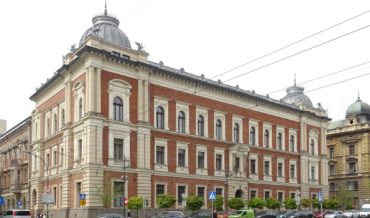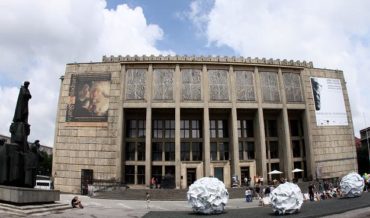Contents
Key Facts
• Born 1908 in Stary Sambor, died 1958 in Kraków at age 50
• Painter, sculptor, and set designer considered one of Poland's most influential avant-garde artists
• Studied for 7 years at the Academy of Fine Arts in Kraków (1928-1935), with additional studies in Paris and Vienna
• Co-founder and set designer at the revolutionary Cricot Theater from 1933
• Underground resistance activist during WWII with documented connections to resistance networks
• Works displayed in major international exhibitions and housed in prestigious collections including the National Museum in Kraków, Museum of Modern Art in Warsaw, and international galleries
• Pioneer of abstract art in Poland and founding member of the Group of Kraków Artists
Early Life and Education
Maria Jarema, known in artistic circles as Jaremianka, was born on November 24, 1908, in Stary Sambor, a culturally diverse town in Austrian Galicia (present-day western Ukraine). This multicultural environment of the former Austro-Hungarian Empire exposed her to various artistic traditions, from Ukrainian folk art to Austrian academic traditions, profoundly shaping her later interdisciplinary artistic approach.
Her formal artistic education began in 1928 at the prestigious Academy of Fine Arts in Kraków, where she studied sculpture under renowned professors including Konstanty Laszczka and Xawery Dunikowski for seven intensive years until 1935. This extended period provided her with exceptional technical mastery in classical sculptural techniques while encouraging experimental approaches that would define her later work.
Recognizing the necessity of international exposure for artistic development, Jarema pursued advanced studies in Paris (1936-1937) and Vienna. In Paris, she encountered the revolutionary works of Constantin Brâncuși and Jean Arp, whose biomorphic abstractions profoundly influenced her sculptural language. Her Viennese experience exposed her to the sophisticated cultural atmosphere of Central European modernism, particularly the Vienna Secession movement's integration of fine and applied arts.
Theatrical Innovation and Cricot Theater
From 1933, Jarema became a founding member and principal set designer of the Cricot Theater, working alongside visionary director Józef Jarema (no relation despite the shared surname) and later collaborating with Tadeusz Kantor. Her multifaceted role as set designer, costume creator, and occasional actress demonstrated her comprehensive understanding of theatrical space and performance dynamics.
Her revolutionary set designs incorporated sculptural elements and abstract forms, fundamentally challenging traditional illusionistic stage conventions. Notable productions featuring her designs included "The Return of Odysseus" (1944) and "The Cuttlefish" (1956), where she created three-dimensional, interactive stage environments that performers could manipulate during performances. These innovations directly influenced the development of happenings and performance art in Poland.
Her extension into puppet theater work, particularly at the Groteska Theater, showcased her sculptural expertise in creating sophisticated marionettes and stage objects. Works like her puppet designs for "The Fantastic Adventures of Baron Munchausen" demonstrated her ability to translate avant-garde sculptural concepts into accessible theatrical forms, elevating puppet theater from entertainment to serious artistic expression.
Wartime Resistance and Artistic Courage
During World War II, Jarema actively participated in Polish underground resistance activities. Historical records document her involvement with the Armia Krajowa (Home Army) network in Kraków, where she utilized her theatrical connections and artistic skills to support Home Army resistance activities. Her apartment served as a meeting place for resistance members, and she created false identification documents using her graphic design expertise.
Her continued artistic production during the occupation period included creating works that subtly encoded resistance messages through symbolic imagery. The sculpture series "Hidden Forms" (1943-1944), created in secret, employed abstract biomorphic shapes that art historians interpret as metaphors for Polish cultural resilience under oppression. These wartime experiences profoundly influenced her post-war artistic philosophy, emphasizing art's capacity for both aesthetic innovation and social engagement.
Artistic Development and Signature Style
Maria Jarema developed a distinctive artistic language that synthesized European avant-garde influences with uniquely Polish sensibilities. Her evolution from academic realism to radical abstraction paralleled broader European artistic developments while maintaining individual characteristics that distinguished her work internationally. As a key figure in the Polish avant-garde art movement, she helped establish new directions that moved beyond traditional Polish art conventions. Her work emerged within the vibrant context of the broader Polish artistic community while pioneering abstract expressionism.
Sculptural Innovations
Her mature sculptural work, particularly the "Spatial Compositions" series (1950-1958), featured revolutionary abstract forms that challenged conventional figure-ground relationships. Works like "Rhythm in Space" (1955) and "Organic Form III" (1957) employed bronze and experimental materials to create biomorphic abstractions that seemed to grow organically from their bases. These sculptures demonstrated her mastery of negative space and her understanding of sculpture as environmental intervention rather than mere object-making.
Her innovative use of industrial materials, including welded metal and experimental alloys, positioned her among Europe's most progressive sculptors. The monumental work "Ascending Forms" (1956), currently in the National Museum in Kraków collection, exemplifies her mature style's combination of organic inspiration and geometric precision.
Painting and Graphic Innovations
Jarema's painting practice, particularly her unique "monotypia" technique, created translucent, layered compositions that reflected her theatrical understanding of light and space. Works such as "Composition with Circular Elements" (1954) and her series "Spatial Relations" (1955-1957) explored dynamic color relationships and compositional structures that influenced a generation of Polish abstract painters.
Her graphic work, including lithographs and experimental printmaking techniques, often served as preparatory studies for larger sculptural projects while maintaining independent artistic merit. The portfolio "Abstract Variations" (1953) demonstrates her mastery of printmaking as both reproductive and creative medium.
International Recognition and Exhibitions
Maria Jarema achieved significant international recognition during her lifetime, with works exhibited at major European venues including the Venice Biennale (1956), where her sculpture installation received critical acclaim from international art critics. Her participation in the International Sculpture Exhibition in Antwerp (1954) and the Modern Art Festival in Paris (1957) established her reputation beyond Polish borders, earning her international cultural recognition that positioned her among Europe's leading abstract artists.
Contemporary critics, including influential French art historian Michel Seuphor, praised her ability to "synthesize Eastern European spiritual intensity with Western European formal innovation," positioning her work within the broader context of international abstract art while acknowledging its distinctive cultural characteristics.
Museum Collections and Legacy
Today, Jarema's works are housed in major institutional collections worldwide, including the National Museum in Kraków, Museum of Modern Art in Warsaw, Muzeum Sztuki in Łódź, and international collections in Paris, Vienna, and New York. The Maria Jarema Archive, maintained by the National Museum in Kraków, preserves over 200 documented works, extensive correspondence, and photographic documentation of her studio practice. Her works continue to be featured in contemporary art exhibitions and are regularly displayed in various Kraków art galleries.
Her influence on subsequent generations of Polish artists includes direct mentorship relationships with younger sculptors and her role in establishing institutional support for abstract art in post-war Poland. Artists including Magdalena Abakanowicz and Alina Szapocznikow acknowledged Jarema's pioneering work in legitimizing abstract sculpture within Polish artistic discourse. She also played a crucial role in the development of various Kraków avant-garde groups that emerged in the post-war period.
Enduring Impact and Assessment
Maria Jarema's premature death on February 4, 1958, at age 50, cut short one of the most promising careers in mid-century European art. Despite her abbreviated lifetime, she produced over 300 documented works spanning sculpture, painting, graphics, and theatrical design, leaving behind a comprehensive artistic legacy that continues influencing contemporary Polish and international artists.
Her integration of fine art practice with theatrical innovation anticipated later developments in installation and performance art, while her commitment to both aesthetic experimentation and social engagement provides a model for contemporary socially conscious artistic practice. Recent scholarship, including the comprehensive monograph "Maria Jarema: Abstraction and Resistance" (Museum of Modern Art in Warsaw, 2018), has repositioned her work within broader discussions of women's contributions to European modernism and the role of Central European artists in developing international abstract art movements.

